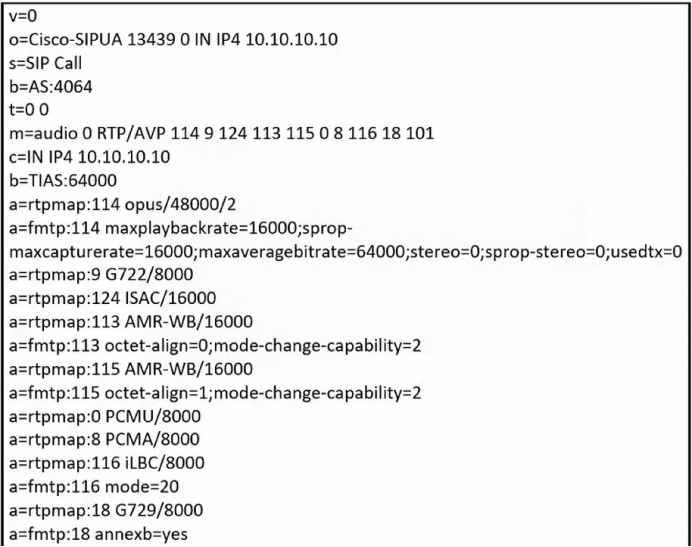Curious about Actual Cisco CCIE Collaboration (350-801) Exam Questions?
Here are sample Cisco Implementing and Operating Cisco Collaboration Core Technologies (350-801) Exam questions from real exam. You can get more Cisco CCIE Collaboration (350-801) Exam premium practice questions at TestInsights.
Refer to the exhibit.
https://i.postimg.cc/C57TkczG/image.png

A call is falling to establish between two SIP Devices The called device answers with these SOP Which SOP parameter causes issue?
Correct : D
The RTP port is used to send and receive media packets during a call. If the RTP port is set to 0, the called device will not be able to send or receive media packets, and the call will fail.
The other options are not correct because:
A) The calling device did not offer a ptime value: The ptime value is used to specify the amount of time between each media packet. If the calling device does not offer a ptime value, the called device will use the default value of 20 milliseconds.
B) The media stream is set to sendonly: The media stream is set to sendonly when the called device is only able to send media packets, and not receive them. This is not a problem, and the call will still succeed.
C) The payload for G.711ulaw must be 18: The payload for G.711ulaw is the type of media packet that is used. The payload must be set to 18 for G.711ulaw, but this is not a problem, and the call will still succeed.
Start a Discussions
Which wildcard must an engineer configure to match a whole domain in SIP route patterns?
Correct : A
The asterisk (*) wildcard is used to match any sequence of characters, including an empty sequence. Therefore, it can be used to match any domain name in a SIP Route Pattern.
The other options are not correct because:
B) @: The @ symbol is used to separate the user name from the domain name in an email address.
C) !: The ! symbol is used to negate a character class.
D) .: The . symbol is used to match any single character.
Start a Discussions
An administrator is asked to implement toll fraud prevention in Cisco UCM, specifically to restrict off-net to off-net call transfers. How is this implemented?
Correct : B
To restrict off-net to off-net call transfers, an administrator can set the 'Block Offnet to Offnet Transfer' service parameter to 'On'. This will prevent users from transferring calls from one external number to another external number.
The other options are not correct because:
A) Enforce ad-hoc conference restrictions: This will prevent users from creating ad-hoc conferences, but it will not prevent them from transferring calls.
C) Implement time-of-day routing: This will allow calls to be routed to different destinations based on the time of day, but it will not prevent users from transferring calls.
D) Use the correct route filters: This will allow calls to be filtered based on the destination, but it will not prevent users from transferring calls.
Start a Discussions
An administrator must implement toll fraud prevention on Cisco UCM using these parameters:
* Enable Forced Authorization Code 112211.
* Set an authorization level of 3 for the route pattern 8005551212.
* Require no access code to dial 10-digit numbers.
How must the route pattern be implemented?
Correct : A
To implement toll fraud prevention on Cisco UCM, an administrator can use the following parameters:
Enable Forced Authorization Code 112211.
Set an authorization level of 3 for the route pattern 8005551212.
Require no access code to dial 10-digit numbers.
The route pattern must be implemented as follows:
Pattern = 1122113.8005551212
This will require users to enter the authorization code 112211 followed by the number 8005551212 to dial this number. The authorization level of 3 will prevent users from transferring calls to this number.
Start a Discussions
What is required when deploying co-resident VMs by using Cisco UCM?
Correct : C
When deploying co-resident VMs by using Cisco UCM, it is important to avoid hardware oversubscription. This means that you should not assign more resources to the VMs than the physical hardware can provide. For example, if you have a server with 16 CPU cores, you should not assign more than 16 CPU cores to the VMs.
If you oversubscribe the hardware, the VMs will not be able to get the resources they need to run properly. This can lead to performance problems and even outages.
To avoid hardware oversubscription, you should carefully plan your VM deployments. You should also monitor the performance of the VMs to make sure that they are not overusing the resources.
Here are some additional tips for deploying co-resident VMs by using Cisco UCM:
Use a virtualization platform that supports Cisco UCM.
Make sure that the VMs have the correct operating system and software installed.
Configure the VMs to use the correct network settings.
Monitor the performance of the VMs to make sure that they are running properly.
Start a Discussions
Total 273 questions